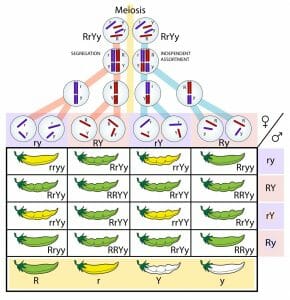Mendel’s laws of heredity refer to the Austrian monk Gregor Mendel who lived in the early 1800s. He conducted experiments crossing varied sizes and colors of pea plants which revolutionized the understanding of heredity. Taken together, his laws make up the principles of Mendelian inheritance.
At the time of his experiments, Mendel knew nothing about genes or chromosomes. But through his work he came to understand that garden peas transmit their visible traits (phenotypes) like color and height to their offspring in a measurable way. Also, Mendel found that through careful observation and record keeping, he could predict the color and height of pea plants.
Mendel’s First Law – The Law of Segregation
The law of segregation says parental genes for a trait must segregate (separate) equally and randomly into haploid gametes so that their offspring have an equal chance of inheriting either allele. This is what happens during meiosis. Offspring inherit one allele from each parent for a trait and no allele is favored or has an advantage over the others. Figure 1 shows the male and female pea gametes that resulted from segregation of the pod color and texture traits during meiosis.
Mendel’s Second Law – The Law of Independent Assortment
Mendel’s second law says that alleles for traits are passed on independently of each other. To put it another way, the selection of an allele for a trait has nothing to do with which allele is selected for a different trait. Mendel discovered this natural law while doing dihybrid cross experiments. Up to that point, he had been studying monohybrid crosses which examined just one trait in the pea plants like color or height. These crosses resulted in a 3:1 ratio between dominant and recessive traits. But in dihybrid crosses testing the outcome of both traits (see Figure 1), Mendel found a 9:3:3:1 ratio which shows the independent inheritance of each trait.
Mendel’s Third Law – The Law of Dominance
Also known as simple dominance, Mendel’s third law means that for the two alleles of a gene, the dominant allele is always expressed because it masks the recessive allele. Recessive traits are only seen when both alleles are recessive. Mendel’s monohybrid cross experiments show this. In Figure 1, the peas have green pods (R) even if they have one allele for yellow pods (r); i.e., RrYy, RrYY. To have yellow pods, the peas must be heterozygous recessive (rr) for the trait. The same is true for the dominant trait of rough pods (Y) and recessive smooth pods (y). The pods are only smooth if they are homozygous recessive (yy).

Figure 1 – The image above illustrates the 3 laws of Mendelian inheritance using parental pea plants that are heterozygous dominant for green, rough pods.
Non-Mendelian Inheritance
There are patterns of inheritance in sexually reproducing organisms that don’t follow the principles of Mendelian inheritance. For example, incomplete dominance results when two dominant traits “blend” to create a third phenotype. This is seen when a plant with red flowers is crossed with a plant with white flowers, resulting in plants with pink flowers. Codominance occurs when two dominant alleles are expressed in the phenotype, such as a chicken with black feathers and a chicken with white feathers having offspring with black and white feathers.
References
- OpenStax College. (2018). Anatomy & Physiology. Houston, TX. OpenStax CNX. Retrieved from http://cnx.org/contents/14fb4ad7-39a1-4eee-ab6e-3ef2482e3e22@8.119
- Mendelian Inheritance. (n.d.). In Wikipedia. Retrieved March 30, 2018 from https://en.wikipedia.org/wiki/Mendelian_inheritance
Mendel"s Law of Heredity
No comments:
Post a Comment